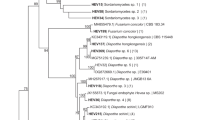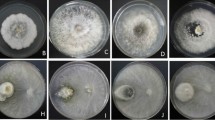Abstract
Fungal endophytes were isolated from leaves of Centella asiatica (Apiaceae) collected at Mangoro (middle eastern region of Madagascar, 200 km from Antananarivo). Forty- five different taxa were recovered. The overall foliar colonization rate was 78%. The most common endophytes were the non-sporulating species 1 (isolation frequency IF 19.2%) followed by Colletotrichum sp.1 (IF 13.2%), Guignardia sp. (IF 8.5%), Glomerella sp. (IF 7.7%), an unidentified ascomycete (IF 7.2%), the non-sporulating species 2 (IF 3.7%) and Phialophora sp. (IF 3.5%). Using sequences of the ribosomal DNA internal transcribed spacer (ITS) regions, major endophytes (IF > 7%) were identified as xylariaceous taxa or as Colletotrichum higginsianum, Guignardia mangiferae and Glomerella cingulata. Results from in vitro fungal disk experiments showed a strong inhibitory activity of the xylariaceous non-sporulating species 1 against G. mangiferae and C. higginsianum and of C. higginsianum against G. mangiferae. This can be explained by antagonism between dominant taxa.


Similar content being viewed by others
Abbreviations
- ASCO1:
-
Unidentified ascomycete
- CR:
-
Colonization rate
- IF:
-
Isolation frequency
- IMRA:
-
Institut Malgache de Recherches Appliquées
- MEAC:
-
Malt extract agar with chloramphenicol
- NSS:
-
Non-sporulating species
References
Arnold AE, Maynard Z, Gilbert GS (2001) Fungal endophytes in dicotyledonous neotropical trees: patterns of abundance and diversity. Mycol Res 105:1502–1507
Boccon-Gibod J (1982) La technologie de la culture in vitro. In: Augé R, Beauchesne G, Boccon-Gibod J, Decourtye L, Digat B, Minier R, Morand JC, Oudin Y, Vidalie H (eds) La culture in vitro et ses applications horticoles. Techniques et Documentation, Lavoisier, Paris, pp 47–73
Boiteau P, Ratsimamanga AR (1956) L’asiaticoside extrait de Centella asiatica et ses emplois thérapeutiques dans la cicatrisation des plaies expérimentales et rebelles (lèpre, tuberculose cutanée et lupus). Thérapie 11(1):125–149
Brown KB, Hyde KD, Guest DI (1998) Preliminary studies on endophytic fungal communities of Musa acuminata species complex in Hong Kong and Australia. Fungal Divers 1:27–58
Cannon PF, Simmons CM (2002) Diversity and host preference of leaf endophytic fungi in the Iwokrama forest reserve, Guyana. Mycologia 94:210–220
Clay K (1988) Fungal endophytes of grasses: a defense mutualism between plants and fungi. Ecology 69:10–16
Deckert RJ, Melville L, Peterson RL (2001) Structural features of a Lophodermium endophyte during the cryptic life-cycle in the foliage of Pinus strobus. Mycol Res 105:991–997
Espinosa-Garcia FJ, Rollinger JL, Langenheim JH (1996) Coastal redwood leaf endophytes: their occurrence, interactions and response to host volatile terpenoids. In: Redlin SC, Carris LM (eds) Endophytic fungi in grasses and woody plants. APS Press, San Diego, CA, pp 101–120
Fröhlich J, Hyde KD, Petrini O (2000) Endophytic fungi associated with palms. Mycol Res 104:1202–1212
Fuhrmann J (1994) Isolation of microorganisms producing antibiotics. In: Weaver RW, Angle S, Bottomley P, Bezdicek D, Smith S, Tabatabai A, Wollum A (eds) Methods of soil analysis, Part 2. Microbiological and biochemical properties-SSSA book series, no.5, Madison, WI, pp 379–405
Gamboa MA, Bayman P (2001) Communities of endophytic fungi in leaves of a tropical timber tree (Guarea guidonia: Meliaceae). Biotropica 33:352–360
Guo LD, Huang GR, Wang Y et al (2003) Molecular identification of white morphotype strains of endophytic fungi from Pinus tabulaeformis. Mycol Res 107:680–688
Hata K, Atari R, Sone K (2002) Isolation of endophytic fungi from leaves of Pasania edulis and their within-leaf distributions. Mycoscience 43:369–373
Kumaresan V, Suryanarayanan TS (2001) Occurrence and distribution of endophytic fungi in mangrove community. Mycol Res 105:1388–1391
Higgins BB (1917) A Colletotrichum leafspot of turnips. J Agric Res 10:157–161
Lee SB, Milgroom MG, Taylor JW (1988) A rapid, high yield mini prep method for isolation of total genomic DNA from fungi. Fungal Genet Newslett 35:23–24
Li JY, Harper JK, Grant DM et al (2001) Ambuic acid, a highly functionalized cyclohexenone with antifungal activity from Pestalotiopsis spp. and Monochaetia sp. Phytochemistry 56:463–468
Lu H, Zou WX, Meng JC et al (2000) New bioactive metabolites produced by Colletotrichum sp., an endophytic fungus in Artemisia annua. Plant Sci 151:67–73
Narusaka Y, Narusaka M, Park P et al (2004) RCH1, a locus in Arabidopsis that confers resistance to the hemibiotrophic fungal pathogen Colletotrichum higginsianum. Mol Plant-Microbe Interact 17(7):749–762
Petrini O (1986) Taxonomy of endophytic fungi of aerial plant tissues. In: Fokkema NJ, Van den Heuvel J (eds) Microbiology of the Phyllosphere. Cambridge University Press, Cambridge, pp 175–187
Petrini O (1991) Fungal endophytes of tree leaves. In: Andrews JH, Hirano SS (eds) Microbial ecology of leaves. Springer Verlag, New York, pp 179–187
Petrini O, Stone J, Carroll FE (1982) Endophytic fungi in evergreen shrubs in western Oregon: a preliminary study. Can J Bot 60:789–796
Pointel JP, Boccalon H, Cloarec M et al (1987) Titrated extract of Centella asiatica (TECA) in the treatment of venous insufficiency of the lower limbs. Angiology 38(1 Pt 1):46–50
Porter JK, Bacon CW, Robbins JD (1979) Lysergic acid amide derivatives from Balansia epichloe and Balansia claviceps (Clavicipitaceae). J Nat Prod 42:309–314
Rodrigues KF (1994) The foliar fungal endophytes of the Amazonian palm Euterpe oleracea. Mycologia 86:376–385
Rodrigues KF, Petrini O (1997) Biodiversity of endophytic fungi in tropical regions. In: Hyde KD (ed) Biodiversity of tropical microfungi. Hong Kong University Press, Hong Kong, pp 57–69
Rodrigues KF, Drandarov K, Heerklotz J et al (2001) Guignardic acid, a novel type of secondary metabolite produced by the endophytic fungi Guignardia sp.: isolation, structure elucidation and asymmetric synthesis. Helv Chim Acta 84:3766–3772
Schaneberg BT, Mikell JR, Bedir E et al (2003) An improved HPLC method for quantitative determination of six triterpenes in Centella asiatica extracts and commercial products. Pharmazie 58:381–384
Schulz B, Guske S, Dammann U et al (1998) Endophyte-host interactions II. Defining symbiosis of the endophyte-host interaction. Symbiosis 25:213–227
Schulz B, Boyle C, Draeger S et al (2002) Endophytic fungi: a source of biologically active secondary metabolites. Mycol Res 106:996–1004
Schulz B, Boyle C (2005) The endophytic continuum. Mycol Res 109:661–686
Sinclair JB, Cerkauskas RF (1996) Latent infection vs. endophytic colonization by fungi. In: Redlin SC, Carris LM (eds) Endophytic fungi in grasses and woody plants: systematics, ecology and evolution. The American Phytopathological Society, St. Paul, Minnesota, pp 3–29
Stone JK, Bacon CW, White JF (2000) An overview of endophytic microbes: endophytism defined. In: Bacon CW, White JF (eds) Microbial endophytes. Marcel Dekker, New York, pp 3–29
Sutton BC (1992) The genus Glomerella and its anamorph Colletotrichum. In: Bailey JA, Jeger MJ (eds) Colletotrichum – biology, pathology and control. CAB International, Wallingford, pp 1–26
West CP (1994) Physiology and drought tolerance of endophyte-infected grasses. In: Bacon CW, White JF Jr (eds) Biotechnology of endophytic fungi of grasses. CRC press, Boca Raton, pp 87–99
Whalley AJS, Edwards RL (1995) Secondary metabolites and systemic arrangement within the Xylariaceae. Can J Bot 73:802–810
White JF Jr, Cole GT (1985) Endophyte-host associations in forage grasses. III. In vitro inhibition of fungi by Acremonium coenophialum. Mycologia 77:487–489
White TJ, Bruns TD, Lee S et al (1990) Amplification and direct sequencing of fungal ribosomal RNA genes for phylogenetics. In: Innis MA, Gelfand DH, Sninsky JJ, White TJ (eds) PCR protocols: a guide to methods and applications. Academic Press, Inc., New York, pp 315–322
Acknowledgements
This work is part of the research program at IMRA (Institut Malgache de Recherches Appliquées, Madagascar) on Biodiversity and Biotechnology. We wish to thank the Belgian Commission Universitaire pour le Développement (CUD) for contributing financially to this research. Erick Francisco Rakotoniriana is grateful to ADRI/UCL (Administration de la Relation Internationale / Université catholique de Louvain, Belgique) for the doctoral fellowship enabling him to continue this research. Cony Decock and Françoise Munaut gratefully acknowledge the financial backing received from the Belgian Federal Office for Scientific, Technical, and Cultural affairs (OSTC, contract BCCM/MUCL C2/10/007), and thank the directors of MUCL and MBLA for their constant encouragement and the provision of research facilities. We also thank Dr. Geraldine Van der Auwera and Dr. Aro Vonjy Ramarosandratana for critically reading manuscript.
Author information
Authors and Affiliations
Corresponding author
Rights and permissions
About this article
Cite this article
Rakotoniriana, E.F., Munaut, F., Decock, C. et al. Endophytic fungi from leaves of Centella asiatica: occurrence and potential interactions within leaves. Antonie van Leeuwenhoek 93, 27–36 (2008). https://doi.org/10.1007/s10482-007-9176-0
Received:
Accepted:
Published:
Issue Date:
DOI: https://doi.org/10.1007/s10482-007-9176-0




